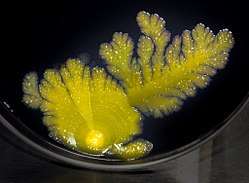Sphingomonadaceae
Sphingomonadaceae are a family of the Alphaproteobacteria. An important feature is the presence of sphingolipids (mainly 2′hydroxymyristol dihydrosphingosine 1-glucuronic acid, "SGL-1") in the outer membrane of the cell wall.[2][3] The cells are ovoid or rod-shaped. Others are also pleomorphic, i.e. the cells change the shape over time. Some species are phototrophic.
| Sphingomonadaceae | |
|---|---|
 | |
| A culture of Sphingomonas phyllosphaerae | |
| Scientific classification | |
| Domain: | Bacteria |
| Phylum: | Proteobacteria |
| Class: | Alphaproteobacteria |
| Order: | Sphingomonadales |
| Family: | Sphingomonadaceae Kosako et al. 2000 |
| Genera[1] | |
| |
Sphingomonadaceae are also known by the ability of some species to degrade some aromatic compounds. This makes the bacteria of interest to environmental remediation.[4]
References
- "Sphingomonadaceae" (HTML). NCBI taxonomy. Bethesda, MD: National Center for Biotechnology Information. Retrieved 13 May 2019.
- Garrity, George M.; Brenner, Don J.; Krieg, Noel R.; Staley, James T. (eds.) (2005). Bergey's Manual of Systematic Bacteriology, Volume Two: The Proteobacteria, Part C: The Alpha-, Beta-, Delta-, and Epsilonproteobacteria. New York, New York: Springer. ISBN 978-0-387-24145-6.
- Ikushiro, H; Islam, MM; Tojo, H; Hayashi, H (August 2007). "Molecular characterization of membrane-associated soluble serine palmitoyltransferases from Sphingobacterium multivorum and Bdellovibrio stolpii". Journal of Bacteriology. 189 (15): 5749–61. doi:10.1128/JB.00194-07. PMC 1951810. PMID 17557831.
- David L. Balkwill, J. K. Fredrickson und M. F. Romine:Sphingomonas and Related Genera In: The Prokaryotes, A Handbook of the Biology of Bacteria. Volume 7: Proteobacteria: Delta and Epsilon Subclasses. Deeply Rooting Bacteria ISBN 978-0-387-33493-6
This article is issued from Wikipedia. The text is licensed under Creative Commons - Attribution - Sharealike. Additional terms may apply for the media files.